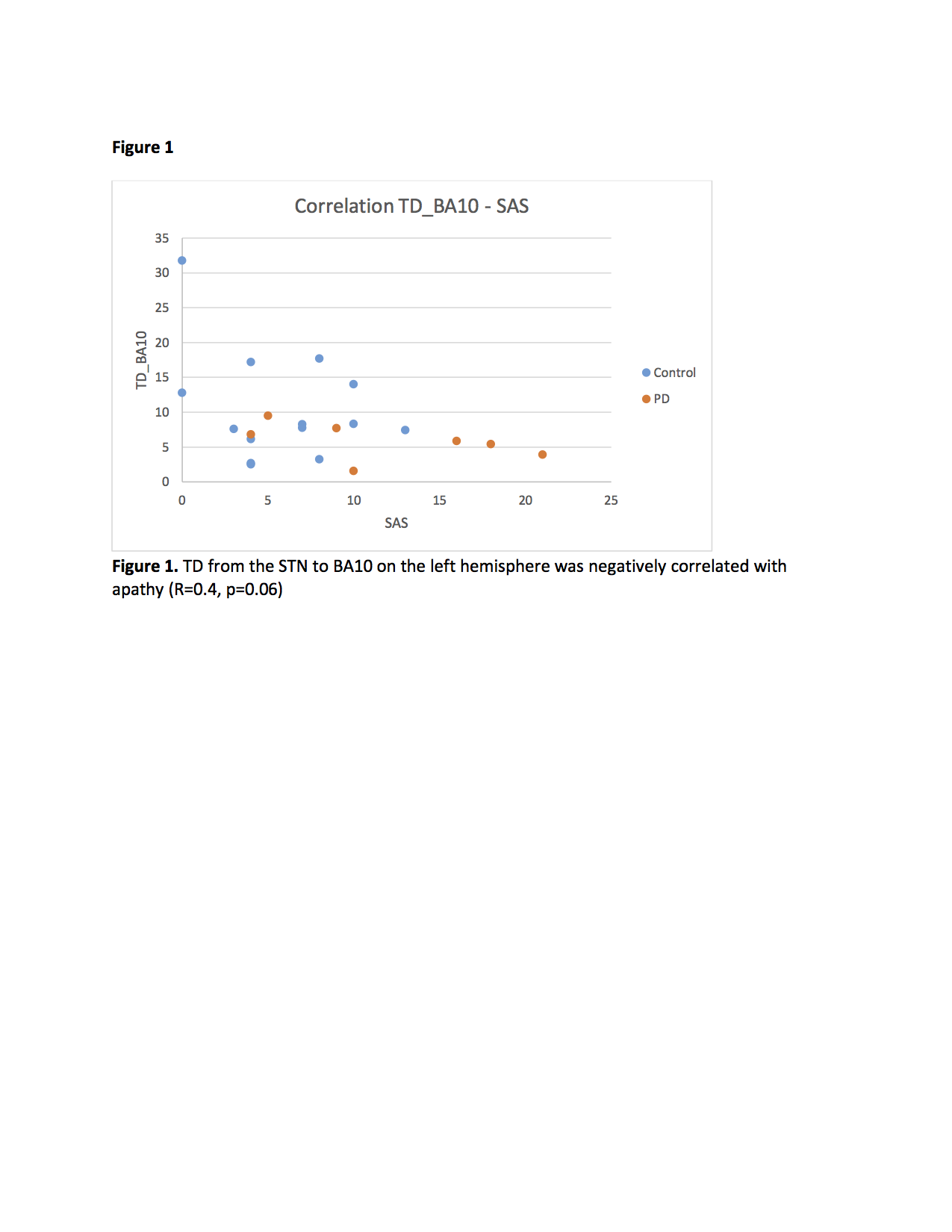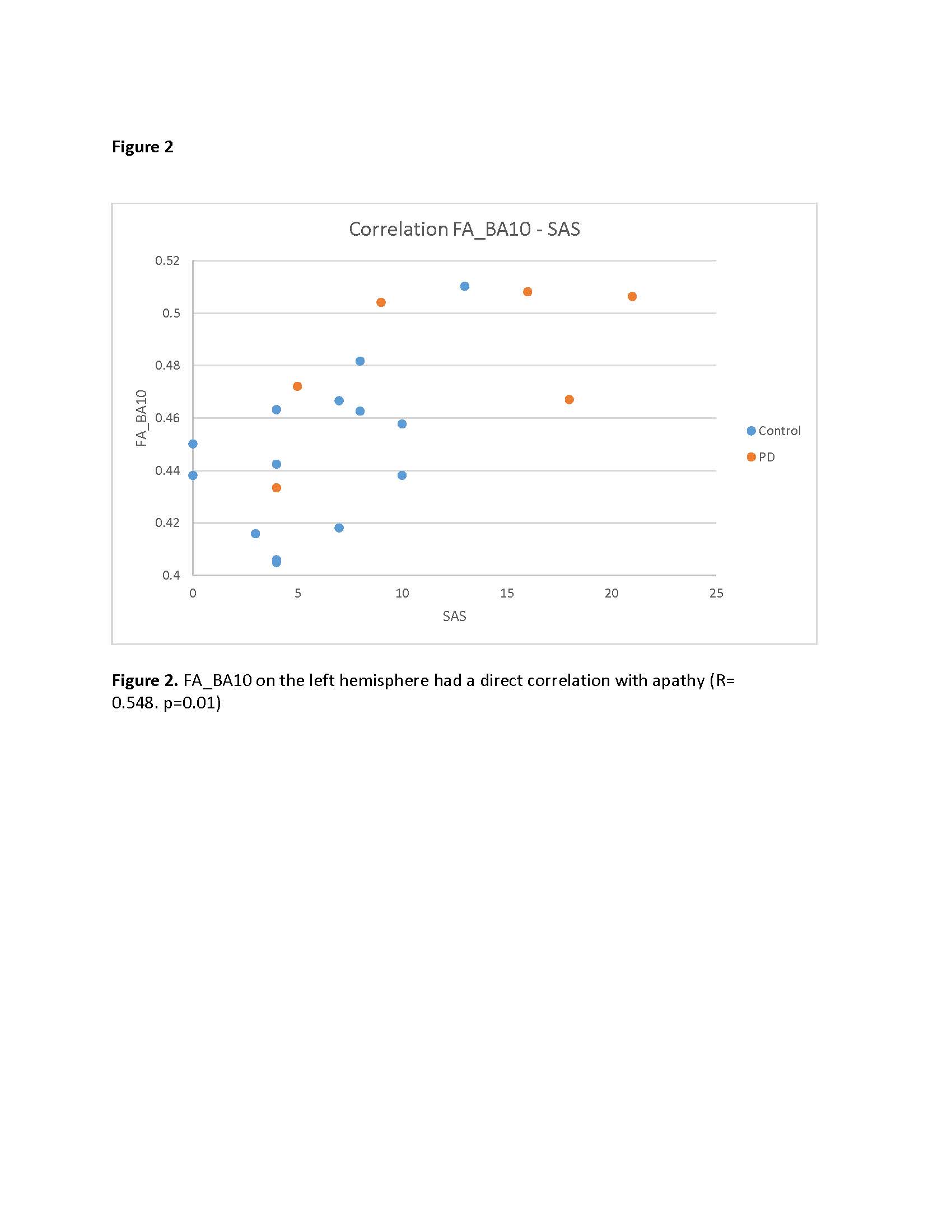Session Information
Date: Monday, October 8, 2018
Session Title: Parkinson's Disease: Neuroimaging And Neurophysiology
Session Time: 1:15pm-2:45pm
Location: Hall 3FG
Objective: We aimed to study the baseline white matter characteristics of tractographically defined subthalamic connectivity using Diffusion Tensor Imaging in Parkinson’s Disease patients and healthy controls.
Background: Apathy is highly prevalent in Parkinson’s Disease (PD) patients, and an independent predictor of lower response to treatment, poor quality of life and caregiver burden. Despite the significant motor benefits obtained as a result of Subthalamic (STN) Deep Brain Stimulation (DBS) therapy, postoperative apathy may reduce any perceived benefit. The presence of metabolic deficits in frontal and cingulate cortices have previously been described in PD patients with apathy. Thus, we hypothesized that loss of integrity of white matter projections from the STN is associated with the development of postoperative apathy.
Methods: Seven patients with PD (57.4 6.3 years) and 14 healthy controls (64.810 years) were enrolled. All subjects underwent a Brain MRI, including high resolution DTI sequences (FOV: 224mm, 112×112, b=2500 s/mm2, 64 directions, spatial resolution 2x2x2mm). Tractography was performed using a probabilistic approach implemented in MRtrix. White-matter microstructural integrity was measured using fractional anisotropy (FA), mean diffusivity (MD), axial diffusivity (AD), radial diffusivity (RD) and tract density (TD). Tractographic measures were obtained for projections from the STN to three ROIs, corresponding to the described main receiving limbic and associative regions (Broadmann Areas 10, 11 and 24). All subjects completed a psychiatric battery, including the Starkstein Apathy Scale (SAS).
Results: TD from the STN to BA10 on the left hemisphere was negatively correlated with apathy (R=0.4, p=0.06), see Figure 1. Conversely, FA_BA10 on the left hemisphere had a positive correlation with apathy (R= 0.548. p=0.01), see Figure 2. In a logistic regression model, using an apathy cut-off score of 14 on the SAS was established as the outcome, two of the above measures were associated with apathy (FA_BA10 p =0.0463 and td_BA10 =0.0455).
Conclusions: Our preliminary analyses suggests that lower tract densities to the Broadmann Area (BA) 10 are associated with the presence of apathy. In addition, higher FA to BA10 was positively correlated with the presence of apathy. Low tract density combined with higher FA values strongly suggest the presence of white matter degeneration in areas with high levels of crossing fibers. Impaired integrity of STN-BA10 connectivity may be implicated in apathy, larger studies are required to confirm our findings.
References: 1. Pagonabarraga, J., et al. Apathy in Parkinson’s disease: Clinical features, neural substrates, diagnosis, and treatment. The Lancet Neurology 14, 518–531 (2015). 2. Robert, G. et al. Apathy in patients with parkinson disease without dementia or depression; A PET study. 79, 1155–1160 (2012). 3. Haynes, W. I. A. & Haber, S. N. The Organization of Prefrontal-Subthalamic Inputs in Primates Provides an Anatomical Substrate for Both Functional Specificity and Integration : Implications for Basal Ganglia Models and Deep Brain Stimulation. 33, 4804–4814 (2013).
To cite this abstract in AMA style:
N. Vanegas-Arroyave, Y. Gazes, D. Tomishon, A. Boehme. Tractographically defined subthalamic connectivity is associated with apathy in Parkinson’s disease and healthy subjects [abstract]. Mov Disord. 2018; 33 (suppl 2). https://www.mdsabstracts.org/abstract/tractographically-defined-subthalamic-connectivity-is-associated-with-apathy-in-parkinsons-disease-and-healthy-subjects/. Accessed January 1, 2026.« Back to 2018 International Congress
MDS Abstracts - https://www.mdsabstracts.org/abstract/tractographically-defined-subthalamic-connectivity-is-associated-with-apathy-in-parkinsons-disease-and-healthy-subjects/


